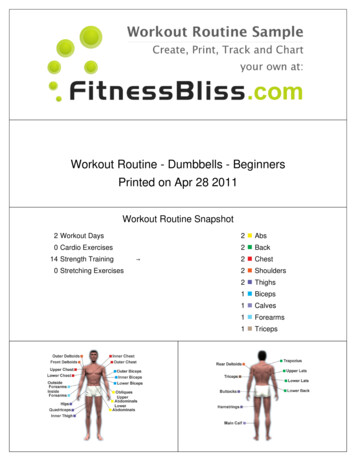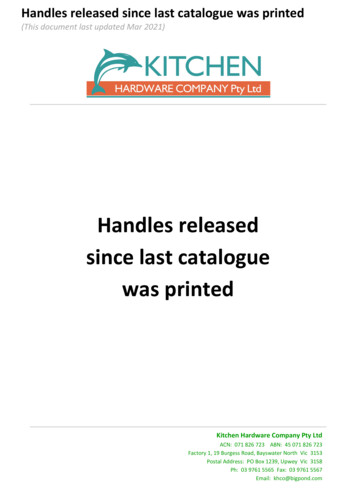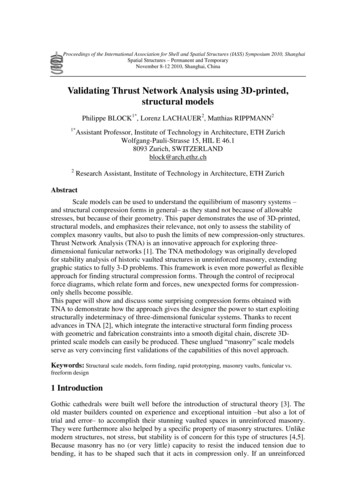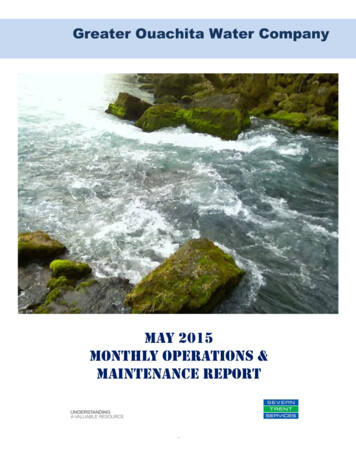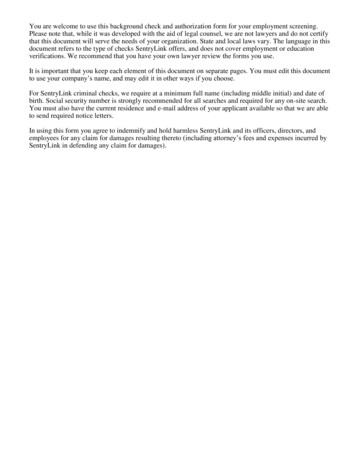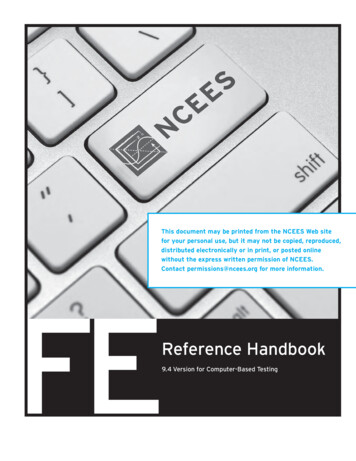
Transcription
This document may be printed from the NCEES Web sitefor your personal use, but it may not be copied, reproduced,distributed electronically or in print, or posted onlinewithout the express written permission of NCEES.Contact permissions@ncees.org for more information.FEReference Handbook9.4 Version for Computer-Based Testing
Copyright 2013 by NCEES . All rights reserved.All NCEES material is copyrighted under the laws of the United States. No part of this publication may be reproduced, stored in aretrieval system, or transmitted in any form or by any means without the prior written permission of NCEES. Requests for permissionsshould be addressed in writing to permissions@ncees.org.PO Box 1686Clemson, SC 29633800-250-3196www.ncees.orgISBN 978-1-932613-67-4Printed in the United States of AmericaFourth printing June 2016Edition 9.4
PREFACEAbout the HandbookThe Fundamentals of Engineering (FE) exam is computer-based, and the FE Reference Handbook is the onlyresource material you may use during the exam. Reviewing it before exam day will help you become familiarwith the charts, formulas, tables, and other reference information provided. You won't be allowed to bring yourpersonal copy of the Handbook into the exam room. Instead, the computer-based exam will include a PDFversion of the Handbook for your use. No printed copies of the Handbook will be allowed in the exam room.The PDF version of the FE Reference Handbook that you use on exam day will be very similar to the printedversion. Pages not needed to solve exam questions—such as the cover, introductory material, index, and examspecifications—will not be included in the PDF version. In addition, NCEES will periodically revise andupdate the Handbook, and each FE exam will be administered using the updated version.The FE Reference Handbook does not contain all the information required to answer every question on theexam. Basic theories, conversions, formulas, and definitions examinees are expected to know have not beenincluded. Special material required for the solution of a particular exam question will be included in thequestion itself.Updates on exam content and proceduresNCEES.org is our home on the web. Visit us there for updates on everything exam-related, includingspecifications, exam-day policies, scoring, and practice tests. A PDF version of the FE Reference Handbooksimilar to the one you will use on exam day is also available there.ErrataTo report errata in this book, send your correction using our chat feature on NCEES.org. We will also posterrata on the website. Examinees are not penalized for any errors in the Handbook that affect an examquestion.
CONTENTSUnits 1Conversion Factors 2Ethics 3Safety 6Mathematics 22Engineering Probability and Statistics 37Chemistry 54Materials Science/Structure of Matter 60Statics 67Dynamics 72Mechanics of Materials 80Thermodynamics 87Fluid mechanics 103Heat Transfer 117Instrumentation, Measurement, and Controls 124Engineering Economics 131Chemical Engineering 138Civil Engineering 146Environmental Engineering 179Electrical and Computer Engineering 200Industrial and Systems Engineering 228Mechanical Engineering 237Index 251Appendix: FE Exam Specifications. 257
UNITSThe FE exam and this handbook use both the metric system of units and the U.S. Customary System (USCS). In the USCS system ofunits, both force and mass are called pounds. Therefore, one must distinguish the pound-force (lbf) from the pound-mass (lbm).The pound-force is that force which accelerates one pound-mass at 32.174 ft/sec2. Thus, 1 lbf 32.174 lbm-ft/sec2. The expression 32.174lbm-ft/(lbf-sec2) is designated as gc and is used to resolve expressions involving both mass and force expressed as pounds. For instance, inwriting Newton's second law, the equation would be written as F ma/gc, where F is in lbf, m in lbm, and a is in ft/sec2.Similar expressions exist for other quantities. Kinetic Energy, KE mv2/2gc, with KE in (ft-lbf); Potential Energy, PE mgh/gc, with PE in(ft-lbf); Fluid Pressure, p ρgh/gc, with p in (lbf/ft2); Specific Weight, SW ρg/gc, in (lbf/ft3); Shear Stress, τ (µ/gc)(dv/dy), with shearstress in (lbf/ft2). In all these examples, gc should be regarded as a force unit conversion factor. It is frequently not written explicitly inengineering equations. However, its use is required to produce a consistent set of units.Note that the force unit conversion factor gc [lbm-ft/(lbf-sec2)] should not be confused with the local acceleration of gravity g, whichhas different units (m/s2 or ft/sec2) and may be either its standard value (9.807 m/s2 or 32.174 ft/sec2) or some other local value.If the problem is presented in USCS units, it may be necessary to use the constant gc in the equation to have a consistent set of ��310–210–1101102103106109101210151018METRIC kMGTPECOMMONLY USED EQUIVALENTS1 gallon of water weighs1 cubic foot of water weighs1 cubic inch of mercury weighsThe mass of 1 cubic meter of water is1 mg/L is8.34 lbf62.4 lbf0.491 lbf1,000 kilograms8.34 lbf/MgalTEMPERATURE CONVERSIONSºF 1.8 (ºC) 32ºC (ºF – 32)/1.8ºR ºF 459.69K ºC 273.15IDEAL GAS CONSTANTSThe universal gas constant, designated as R in the table below, relates pressure, volume, temperature, and number of moles of an idealgas. When that universal constant, R , is divided by the molecular weight of the gas, the result, often designated as R, has units of energyper degree per unit mass [kJ/(kg·K) or ft-lbf/(lbm-ºR)] and becomes characteristic of the particular gas. Some disciplines, notablychemical engineering, often use the symbol R to refer to the universal gas constant R .FUNDAMENTAL CONSTANTSQuantityelectron chargeFaraday constantgas constantmetricgas constantmetricgas constantUSCSgravitation-Newtonian constantgravitation-Newtonian constantgravity acceleration (standard)metricgravity acceleration (standard)USCSmolar volume (ideal gas), T 273.15K, p 101.3 kPaspeed of light in vacuumStefan-Boltzmann constant1UNITSSymboleFRRRRGGggVmcσValue1.6022 10 1996,4858,3148.3141,5450.082066.673 10–116.673 10–119.80732.17422,414299,792,0005.67 10–8UnitsC K)ft-lbf/(lb sec2L/kmolm/sW/(m2·K4)
CONVERSION FACTORSMultiplyByTo ObtainMultiply2acreampere-hr (A-hr)ångström (Å)atmosphere (atm)atm, stdatm, stdatm, stdatm, std43,5603,6001 10–1076.029.9214.7033.901.013 105square feet (ft )coulomb (C)meter (m)cm, mercury (Hg)in., mercury (Hg)lbf/in2 abs (psia)ft, waterpascal 1 1050.987421,0552.928 10–47783.930 10–40.2930.216Paatmgallons–oiljoule (J)kilowatt-hr (kWh)ft-lbfhorsepower (hp)watt (W)ft-lbf/seccalorie (g-cal)calcalcal/seccentimeter (cm)cmcentipoise (cP)centipoise (cP)centipoise (cP)centistoke (cSt)cubic feet/second (cfs)cubic foot (ft3)cubic meters (m3)electronvolt (eV)3.968 10–31.560 10–64.1864.1843.281 10–20.3940.00112.4191 10–60.6463177.4811,0001.602 10–19Btuhp-hrjoule (J)watt (W)foot (ft)inch (in)pascal·sec (Pa·s)g/(m·s)lbm/hr-ftm2/sec (m2/s)million gallons/day (MGD)gallonlitersjoule (J)foot (ft)ftft-pound (ft-lbf)ft-lbfft-lbfft-lbf30.480.30481.285 10–33.766 10–70.3241.356cmmeter (m)Btukilowatt-hr (kWh)calorie (g-cal)joule (J)–3ft-lbf/sec1.818 10horsepower (hp)gallon (U.S. Liq)3.785liter (L)gallon (U.S. Liq)0.134ft3gallons of water8.3453pounds of watergamma (γ, Γ)1 10–9tesla (T)gauss1 10–4Tgram (g)2.205 10–3pound (lbm)hectarehectarehorsepower (hp)hphphphp-hrhp-hrhp-hrhp-hr1 1042.4710442.4745.733,0005502,5451.98 1062.68 1060.746square meters (m2)acresBtu/minwatt (W)(ft-lbf)/min(ft-lbf)/secBtuft-lbfjoule (J)kWhinch (in.)in. of Hgin. of Hgin. of H2Oin. of H2O2.5400.033413.600.03610.002458centimeter (cm)atmin. of H2Olbf/in2 (psi)atm2ByTo Obtain–4joule (J)JJJ/s9.478 100.737611kilogram (kg)kgfkilometer (km)km/hrkilopascal (kPa)kilowatt (kW)kWkWkW-hour (kWh)kWhkWhkip 1.3413.6 1061,0004,448pound (lbm)newton (N)feet (ft)mphlbf/in2 (psi)horsepower (hp)Btu/hr(ft-lbf )/secBtuhp-hrjoule (J)lbfnewton (N)liter (L)LLL/second (L/s)L/s61.020.26410–32.11915.85in3gal (U.S. Liq)m3ft3/min (cfm)gal (U.S.)/min (gpm)meter (m)mm/second (m/s)mile (statute)mile (statute)mile/hour (mph)mphmm of Hgmm of H2O3.2811.094196.85,2801.60988.01.6091.316 10–39.678 10–5feet (ft)yardfeet/min (ft/min)feet (ft)kilometer (km)ft/min (fpm)km/hatmatmnewton (N)newton (N)N·mN·m0.22510.73761lbfkg·m/s2ft-lbfjoule (J)pascal (Pa)PaPa·sec (Pa·s)pound (lbm, avdp)lbflbf-ftlbf/in2 (psi)psipsipsi9.869 here (atm)newton/m2 (N/m2)poise (P)kilogram (kg)NN·matmft of H2Oin. of HgParadian180/πdegreestokes1 10–4m2/sthermton (metric)ton (short)1 1051,0002,000Btukilogram (kg)pound (lb)watt (W)WWweber/m2 (Wb/m2)3.4131.341 10–3110,000Btu/hrhorsepower (hp)joule/s (J/s)gaussCONVERSION FACTORSBtuft-lbfnewton·m (N·m)watt (W)
ETHICSCODES OF ETHICSEngineering is considered to be a "profession" rather than an"occupation" because of several important characteristics sharedwith other recognized learned professions, law, medicine, andtheology: special knowledge, special privileges, and specialresponsibilities. Professions are based on a large knowledge baserequiring extensive training. Professional skills are importantto the well-being of society. Professions are self-regulating,in that they control the training and evaluation processes thatadmit new persons to the field. Professionals have autonomyin the workplace; they are expected to utilize their independentjudgment in carrying out their professional responsibilities.Finally, professions are regulated by ethical standards. (Harris,C.E., M.S. Pritchard, & M.J. Rabins, Engineering Ethics:Concepts and Cases, Wadsworth Publishing company, pages27–28, 1995.)No code can give immediate and mechanical answers to allethical and professional problems that an engineer may face.Creative problem solving is often called for in ethics, just as it isin other areas of engineering.Model Rules, Section 240.15, Rules of Professional ConductTo safeguard the health, safety, and welfare of the public and tomaintain integrity and high standards of skill and practice in theengineering and surveying professions, the rules of professionalconduct provided in this section shall be binding upon everylicensee and on all firms authorized to offer or performengineering or surveying services in this jurisdiction.A. Licensee's Obligation to the Public1. Licensees shall be cognizant that their first and foremostresponsibility is to safeguard the health, safety, andwelfare of the public when performing services forclients and employers.2. Licensees shall sign and seal only those plans, surveys,and other documents that conform to acceptedengineering and surveying standards and that safeguardthe health, safety, and welfare of the public.3. Licensees shall notify their employer or client andsuch other authority as may be appropriate when theirprofessional judgment is overruled under circumstancesin which the health, safety, or welfare of the public isendangered.4. Licensees shall, to the best of their knowledge, includeall relevant and pertinent information in an objectiveand truthful manner within all professional documents,statements, and testimony.5. Licensees shall express a professional opinion publiclyonly when it is founded upon an adequate knowledgeof the facts and a competent evaluation of the subjectmatter.6. Licensees shall issue no statements, criticisms, orarguments on engineering and surveying matters thatare inspired or paid for by interested parties, unless theyexplicitly identify the
personal copy of the Handbook into the exam room. Instead, the computer-based exam will include a PDF version of the Handbook for your use. No printed copies of the Handbook will be allowed in the exam room. The PDF version of the FE Reference Handbook that you use on exam day will be very similar to the printed version. Pages not needed to solve exam questions—such as the cover, introductory


